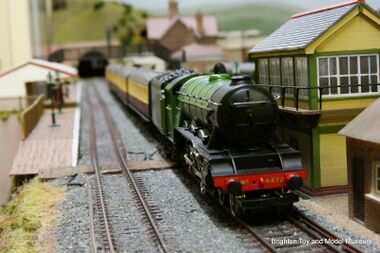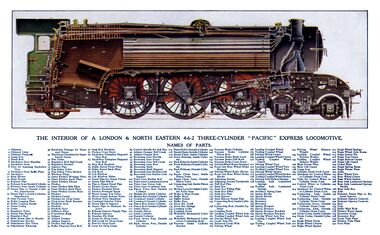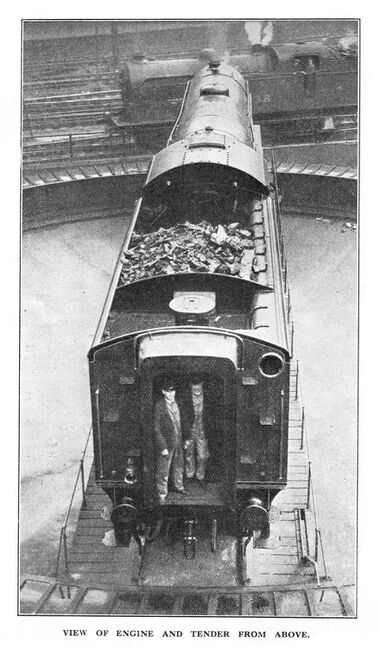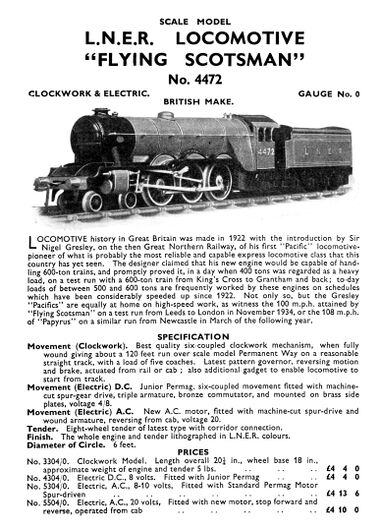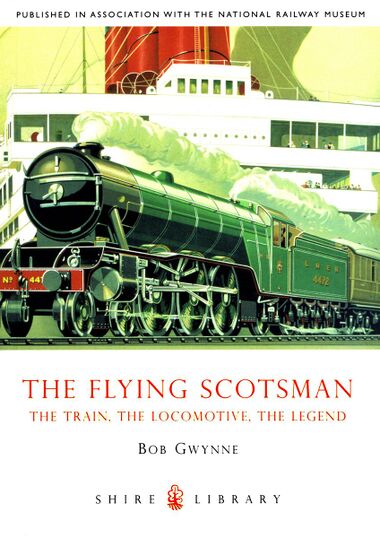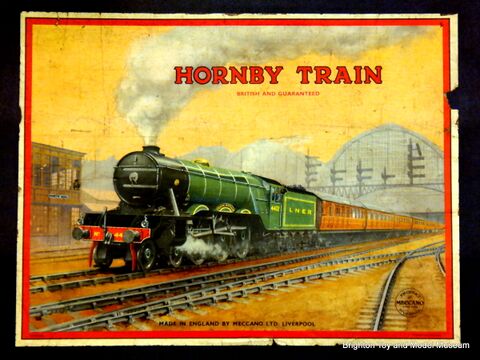Category:Flying Scotsman (locomotive): Difference between revisions
(sentence moved from later in the article to the intro) |
m (Text replacement - "{{#seo:" to "{{#SEO:") |
||
| (33 intermediate revisions by 2 users not shown) | |||
| Line 1: | Line 1: | ||
{{#SEO: |title=Flying Scotsman Gresley A1/A3 steam locomotive (1923-), LNER/BR, 4472/502/103/60103 |titlemode=replace |description=The iconic "Flying Scotsman" 4-6-2 steam locomotive first appeared in 1923 under the auspices of the LNER, with running number 4472. }} | |||
{{Box|Flying_Scotsman_nameplate_artwork.jpg|Flying Scotsman 4472 locomotive nameplate (artwork)|380}} | {{Box|Flying_Scotsman_nameplate_artwork.jpg|Flying Scotsman 4472 locomotive nameplate (artwork)|380}} | ||
{{Box|Flying_Scotsman_4472_at_signalbox,_00-gauge_layout.jpg|A Hornby Flying Scotsman on the museum's 00-gauge layout|380}} | {{Box|Flying_Scotsman_4472_at_signalbox,_00-gauge_layout.jpg|A Hornby Flying Scotsman on the museum's 00-gauge layout|380}} | ||
| Line 4: | Line 5: | ||
{{Box|Flying_Scotsman_locomotive,_cross-section_(WBoR_14ed).jpg|Cutaway diagram of the Flying Scotsman's locomotive class, with parts list|380}} | {{Box|Flying_Scotsman_locomotive,_cross-section_(WBoR_14ed).jpg|Cutaway diagram of the Flying Scotsman's locomotive class, with parts list|380}} | ||
{{Box|Flying_Scotsman_LNER_4472_with_new_tender_(TRM_1928-05).jpg|1928: LNER 4472 Flying Scotsman with new corridor tender|380}} | {{Box|Flying_Scotsman_LNER_4472_with_new_tender_(TRM_1928-05).jpg|1928: LNER 4472 Flying Scotsman with new corridor tender|380}} | ||
{{Box|Flying_Scotsman_corridor_tender,_rear_view_(TRM_1928-05).jpg|Aerial view of the Scotsman's corridor tender, seen from the rear. The small circle on the right is the window|380}} | |||
{{Box|The_Wonder_Book_of_Railways,_14th_edition,_cover.jpg|View from the cab, front cover of "The Wonder Book of Railways", ''circa'' ~1928(?)|380}} | {{Box|The_Wonder_Book_of_Railways,_14th_edition,_cover.jpg|View from the cab, front cover of "The Wonder Book of Railways", ''circa'' ~1928(?)|380}} | ||
{{Box|Bassett-Lowke,_Flying_Scotsman,_gauge_0_(BL-MR_1937-11).jpg|Bassett-Lowke ''Flying Scotsman'' model, 1937|380}} | {{Box|Bassett-Lowke,_Flying_Scotsman,_gauge_0_(BL-MR_1937-11).jpg|Bassett-Lowke ''Flying Scotsman'' model, 1937|380}} | ||
| Line 9: | Line 11: | ||
'''The Flying Scotsman''' is one of Britain's most famous steam locomotives, and was a favourite with toy manufacturers. It's usually depicted with [[LNER]] running number 4472, and green paintwork. It was named after the famous Flying Scotman express train service. | '''The Flying Scotsman''' is one of Britain's most famous steam locomotives, and was a favourite with toy manufacturers. It's usually depicted with [[LNER]] running number 4472, and green paintwork. It was named after the famous Flying Scotman express train service. | ||
The Scotsman set speed records, ran a special London-to-Edinburgh trip during the last year of general steam on the British Railways network, and then went on tour in the US and Australia, where it logged the longest noted non-stop steam train journey. It's the last surviving member of the Gresley [[4-6-2]] A1/A3 "Pacific" locomotives, and it currently resides in the [[National Railway Museum]]. | The Scotsman set speed records, ran a special London-to-Edinburgh trip during the last year of general steam on the British Railways network, and then went on tour in the US and Australia, where it logged the longest noted non-stop steam train journey. It's the last surviving member of the Gresley [[4-6-2]] '''A1/A3 Class''' "Pacific" locomotives, and it currently resides in the [[National Railway Museum]]. | ||
== | ==1922: The GNR A1 Class== | ||
The [[ | The first two Gresley '''A1 class''' locomotives were built at Doncaster Works by the Great Northern Railway in 1922, around eight months and five months before before the grouping of the myriad railway companies to form the [[Big Four]] on January 1st 1923. These were the GNR's first 4-6-2 locomotives, and were initially numbered '''1470 ''Great Northern''''' and '''1471 ''Sir Frederick Banbury''''' (named after the soon-to-be defunct railway company, and its outgoing chairman). They were renumbered '''4470''' and '''4471''' when they became part of the LNER. | ||
A further batch of ten A1 locomotives were ordered in 1922 and arrived in 1923, so the first of this second batch, and the first Class A1 to be an ''exclusively'' LNER locomotive, was '''4472''', later to be named ''''Flying Scotsman'''''. | |||
== | ==1923: The creation of the LNER== | ||
The LNER legally came into existence at the dawn of 1923. With the new railway company being launched and branded, the LNER's new head of publicity seized on the A1 Class as the company's newest and biggest passenger locomotives, and decided to make them the public "face" of the LNER. When selecting a single loco to be used for publicity, it was sensible ''not'' to use the first two A1's which had already run under the GNR and were named after the GNR and GNR chairman. The first of the new LNER batch, 4472, was deliberately left unnnamed during 1923, as the company decided exactly how to get maximum publicity from the locomotive. | |||
==1924-1925: Launch and public showings== | |||
The opportunity for a big publicity launch for 4472 came in 1924, with the high-profile '''[[British Empire Exhibition]]'''. | |||
==1969: The US Tour== | 4472 was duly named, and since it was going to be a staple of LNER publicity, the company decided to try to get a "double-hit" of exposure from the loco - instead of naming it after a famous person, or a town, or some other recognisable name that had nothing to do with the LNER, the company named the locomotive after their own high-profile London-to-Edinburgh service (which the loco would be used on), the Flying Scotsman. This meant that every time the LNER promoted the locomotive, it was advertising the service, and every time people took the Flying Scotsman train, hauled by an A1, they felt as if they were in the presence of a "celebrity" loco (even though most of the trains were actually hauled by 4472's sister A1 locomotives). | ||
The North American tour of The Flying Scotsman would take it | |||
Since 4472 had had a lot of heavy use after it had been introduced in 1923, and then spent a lot of time during 1924 on display at the British Empire Exhibition, and returned to the BEE in 1925, 4472 probably spent less time hauling the FS train after its naming than some of its siblings. However, the Exhibition's estimated 27 million visitors helped to establish the ''Scotsman'' as part of the national identity. | |||
{{BigPic|Flying_Scotsman,_article_(MM_1928-04).jpg|"To the North with the Flying Scotsman: On the Footplate with Driver and Fireman", by R.S. Lyons, [[Meccano Magazine]], April 1928}} | |||
==1928: Non-stop service and corridor tenders== | |||
The LNER publicity department got a "second bite of the cherry" in 1928 with regards to the Scotsman by relaunching the train service on 1st May as a new non-stop service, without the stop-off for lunch along the route that was originally part of the schedule. With a distance of 392 miles, this gave the ''Scotsman'' train the ability to boast of being the World's longest non-stop scheduled steam locomotive-run service. | |||
Since it was impractical to expect a single driver and fireman to stay alert and shovel coal for the entire trip without a break, the new service was only made possible by the construction of a new type of tender to be attached to the engine, which, as well as carrying an extra ton of coal, contained a concealed tunnel that let first- and second-shift crews swap places without stopping the train. The engine-facing end of the tender had a small hatch over this tunnel-corridor, which ran inside the right-hand side of the tender, then had a sharp turn leading to a central concertina-style connector that linked to the front of the third-class carriage at the front of the train, where crews would sit when off-shift. Daylight entered the corridor from a small round window at the back of the tender, so as not to spoil the symmetrical appearance of the tender sides. | |||
These innovative corridor tenders were also used with some other LNER express passenger locomotives such as the [[A4]]s, and were instrumental in making the Scotsman's Australian tour feasible. | |||
==1929: Feature film: "The Flying Scotsman"== | |||
The LNER cooperated with filmmakers in the production of a six-reel silent film called "The Flying Scotsman". Featuring the real locomotive on a loop of track, the film starred '''Pauline Johnson''' and included the first film appearance of '''Raymond Milland''', and was later given a partial soundtrack. Although the film must have originally seemed to the LNER like a wonderful opportunity, they later became alarmed and then somewhat panicked at the idea that the plot involved a disgruntled sacked railway driver plotting to cause a railway accident, and featured some slightly terrifying stunts performed for real, without the use of stunt-men, such as actors crawling along the outside of the train at high speed. | |||
==1934: The 100mph speed record== | |||
In another publicity coup, the LNER organised a successful attempt to set a new official speed record for a steam locomotive, of 100mph. | |||
The natural candidate for this was again 4472, not because it was necessarily any faster than its siblings, but because the name "Flying Scotsman" would then also be famous for belonging to the world's fastest steam loco. | |||
The record-breaking run was made on 30 November 1934, with the driver cryptically mentioning to one of the passengers before the train left that station that, "If we hit anything today, we'll hit it hard". A special measurement "dynamometer car" was attached to the train to make sure that there was an official record of the event – a steam loco had been reputed to have travelled briefly at 100mph before, but without independent verification - the LNER wanted their record-breaking run to be "proper", official and undisputable. | |||
==1959: A3 rebuild== | |||
A set of modifications and improvements to the A1 class had started being implemented (very slowly!) in 1928, with the resulting locomotives being reclassified as '''A3 Class'''. | |||
The "A3" updates to ''Scotsman'' were finished in 1959, giving it an improved boiler and an enhanced "Kylchap" double-chimney similar to the one on Mallard, and an elongated steam dome. However, the internal efficiency improvements, which meant that more energy was extracted from the steam, meant that smoke and steam didn't blast out of the chimney as strongly, and tended to drift across the driver's field of view. | |||
In order to fix the problem, the same solution used by many other locomotives such as the "Duchesses" was applied - fixing a pair of smoke-deflector panels to the sides of the front of the loco, to scoop up air to lift the smoke out of the way. However, while many locomotives looked great with smoke deflectors, the high "partial" plates used on ''Scotsman'' while preserving the view of the loco's distinctive lower front boiler supports, were felt by many to make the loco look a bit "prissy", changing its look. | |||
==1963: Private ownership== | |||
Although steam locomotives were not too expensive to build, they were very expensive to maintain, and with the number of steam locomotives on the BR network steadily reducing, there was bound to come a time when maintaining the steam locomotive servicing facilities for a dwindling number of engines would cease to make financial sense. British Rail made a strategic decision to scrap steam, with the Scotsman locomotive scheduled to be sent to the breaker's yard in early 1963. | |||
At this point, businessman '''Alan Pegler''', who had stood in the cab of the ''Scotsman'' as a child when it was exhibited at the British Exhibition, stepped in and bought the locomotive from British Rail, with an agreement that he would be allowed to continue to run it on the BR network for special trips. With ''Scotsman'' no longer a BR locomotive, Pegler had the engine restored to its original LNER/4472 livery, and ran an anniversary-non-stop trip in 1968 to mark the 40th anniversary of the 1928 record-making run. | |||
===1969-1970: The first US Tour=== | |||
The North American tour of The Flying Scotsman would take it 3,500 miles from its home in Britain before starting its 15,400 mile-long journey, taking it across much of America and even as far as Canada. The tour was originally a mission of goodwill to promote trade and cooperation between British and American businesses with attention drawn to British exports to the States. It also allowed the organisers to display the pride felt with the ongoing restoration of such a famous locomotive. The American '''Southern Railways System''' and its president played official hosts to the Scotsman while it travelled across their railways and assisted in organising parts of the tour that took the locomotive to the networks of other US railway companies. With the American recipients of the Scotsman and the British government participating in and backing the venture, the tour gained much excitement and momentum from both countries. | |||
As well as its ongoing restoration, the locomotive itself underwent several modifications, to ensure its compliance with the '''Federal Railroads Administration'''s regulations on locomotives. Many of these were in regard to the difference between the safety rules of Britain and America. The most noticeable of these modifications were the addition of a "cowcatcher", an additional bell, and an American-style whistle. Additional safety modifications included an airbrake system and a high intensity headlamp. | As well as its ongoing restoration, the locomotive itself underwent several modifications, to ensure its compliance with the '''Federal Railroads Administration'''s regulations on locomotives. Many of these were in regard to the difference between the safety rules of Britain and America. The most noticeable of these modifications were the addition of a "cowcatcher", an additional bell, and an American-style whistle. Additional safety modifications included an airbrake system and a high intensity headlamp. | ||
The Flying Scotsman departed from Liverpool docks on September | The Flying Scotsman departed from Liverpool docks on 19th September 1969 for a ten-day voyage to Boston. Upon its arrival the Scotsman was greeted with the sound of traditional Scottish bagpipes and was unloaded by US Navy cranes and equipment. The Scotsman's first voyage in America would be from Boston, Massachusetts to Hartford, Connecticut. The rest of the 1969-70 season would take the locomotive to New York, Washington and Dallas. This three-month tour proved to be a popular season as the public were described as "waiting in scores" to watch the locomotive pass by, at one point including a whole class of school children who were dismissed early to allow them to view the Scotsman passing by. | ||
The following year the Scotsman would visit Texas, Wisconsin and Montreal. | |||
===1972: The second US Tour=== | |||
Pegler had loved driving the locomotive and running the first tour, and in 1972, with the loco still in the US, he decided to run another on the West Coast, this time without the sponsorship that had helped to support the enterprise the first time around. With finances becoming ever worse, Pegler carried on with the adventure, until he had to declare himself bankrupt towards the end of 1972. | |||
''Scotsman" was warehoused in the US and held as an asset, so that it could be sold to raise money to pay creditors. | |||
===1973: Rescue and return to the UK=== | |||
Anxious that Britain might never see the Flying Scotsman again, '''William McAlpine''' stepped in and cleared the debts, and brought ''Scotsman'' back to Liverpool docks via the Panama Canal in early 1973. MacAlpine ran ''Scotsman'' for over two decades, including multiple refits and repairs. | |||
===1988-1989: Australia=== | |||
The ''Scotsman'' went to Australia in 1988 to participate in the bicentennial anniversary steam railway event '''Aus Steam '88'''. | |||
In 1989, the ''Scotsman'' set a steam endurance record, travelling 422 miles non-stop. | |||
===1996-2003: Flying Scotsman Enterprises=== | |||
With a further major overhaul looming, McAlpine put the locomotive up for sale, and it was bought for £1.45M by '''Tony Marchington'''. | |||
to be further restored. With the refit taking over four years and costing around three quarters on a million pounds, Flying Scotsman Enterprises ran the loco for around another four years before becoming insolvent. ''Scotsman'' was on the block once again. | |||
==2004-: The National Railway Museum== | |||
The '''[[National Railway Museum]]''' managed to raise the money to buy Scotsman in April 2004, bringing the locomotive back into public ownership, and giving ''Scotsman'' a secure place in what many would consider it's natural home, at an organisation dedicated to preserving British railway history, and with the resources to maintain the engine and show it to the British public. Critically, the NRM only came into existence in 1975 to manage a collection that had previously been looked after by BR, and therefore hadn't existed at the time that ''Scotsman'' was originally scrapped. | |||
''Scotsman'''s lengthy overhaul and refit at the NRM finally resulted in the first of a series of public tours around the national railway network in early 2016. | |||
==Running numbers and liveries== | |||
The loco first appeared with the LNER's '''4472''' running number. After reorganisations, it also ended up numbered '''502''', and then '''103''', and when British Rail inherited it, this gained a "60" prefix to become '''60103'''. | |||
The ''Scotsman'' was originally dressed in LNER apple-green, which is how it's usually depicted. However, during [[World War Two]] the locomotive was painted in standard wartime black, and for a period under British Rail, it was BR "Brunswick Green". | |||
Together with the conversion from A1-Class to A3-Class, and the fitting of the upper smoke deflectors, the array of colours, numbers and configurations has created no end of arguments amongst steam enthusiasts as to the "proper" state that ''Scotsman'' ought to be restored to. Should it have the original single chimney, apple-green paint and 4472 number? Or should it be Brunswick green, with smoke deflectors and numbered 60103? Or some other combination? The NRM's current position is that the Scotsman has been restored and updated so many times, the most appropriate state to return it to is the configuration that it had at the end of its period with British Rail. | |||
==Museum models== | ==Museum models== | ||
As well as conventional commercial locomotive models and toys of the Flying Scotsman, the Museum also | As well as conventional commercial locomotive models and toys of the Flying Scotsman, the Museum also used to have a large 2.5-gauge model on display in a glass case upstairs in [[Brighton Station]], set into the glass wall of the ticket office to commemorate the locomotive's visit to Brighton in 1966. This was removed when the station was renovated and partially redesigned in 2012-2013. | ||
{{BigPic|Hornby_Trains,_Flying_Scotsman_4472_box_artwork,_round_sticker_(Meccano_Ltd).jpg|Hornby Series 1930s "Flying Scotsman" box artwork, Meccano Ltd.}} | {{BigPic|Hornby_Trains,_Flying_Scotsman_4472_box_artwork,_round_sticker_(Meccano_Ltd).jpg|Hornby Series 1930s "Flying Scotsman" box artwork, Meccano Ltd.}} | ||
| Line 40: | Line 107: | ||
{{Links}} | {{Links}} | ||
=====history:===== | |||
* [http://www.nrm.org.uk/flyingscotsman/about.aspx About the Flying Scotsman, National Railway Museum (nrm.org.uk)] | * [http://www.nrm.org.uk/flyingscotsman/about.aspx About the Flying Scotsman, National Railway Museum (nrm.org.uk)] | ||
* [http://www.ingenious.org.uk/Read/Exploringandtravelling/FlyingScotsman/Theengine/ The engine: Why is Flying Scotsman famous? (ingenious.org.uk)] | * [http://www.ingenious.org.uk/Read/Exploringandtravelling/FlyingScotsman/Theengine/ The engine: Why is Flying Scotsman famous? (ingenious.org.uk)] | ||
* [https://en.wikipedia.org/wiki/List_of_LNER_Class_A1/A3_locomotives List of LNER Class A1/A3 locomotives (wikipedia.org)] | |||
=====films:===== | |||
* [http://www.imdb.com/title/tt0019889/ "The Flying Scotsman" (1929), Internet Movie Database (imdb.com)] | |||
* [https://www.youtube.com/watch?v=k-juCKen1TU 4472 Flying Scotsman. The worlds most famous Steam Locomotive. (youtube.com)] – ''video'' | |||
=====Australia:===== | |||
* [https://en.wikipedia.org/wiki/Aus_Steam_'88 Aus Steam '88 (wikipedia.org)] | |||
* [https://www.youtube.com/watch?v=i6lTyIq2euY Great Trains - The Flying Scotsman in Australia (youtube.com)] – ''video'' | |||
=====restoration:===== | |||
* [http://www.theguardian.com/uk-news/2015/jul/19/flying-scotsman-restoration-nearing-completion Full steam ahead as Flying Scotsman set to return to mainline by end of 2015 (theguardian.com)] | * [http://www.theguardian.com/uk-news/2015/jul/19/flying-scotsman-restoration-nearing-completion Full steam ahead as Flying Scotsman set to return to mainline by end of 2015 (theguardian.com)] | ||
* [http://www.nrm.org.uk/flyingscotsman/see/photos.aspx Restoration photos - August 2015 (nrm.org.uk)] | * [http://www.nrm.org.uk/flyingscotsman/see/photos.aspx Restoration photos - August 2015 (nrm.org.uk)] | ||
* [http://www.rail.co.uk/rail-news/2013/damning-flying-scotsman-report-issued-by-nrm/ Damning Flying Scotsman report issued by National Railway Museum, April 2013 (rail.co.uk)] | * [http://www.rail.co.uk/rail-news/2013/damning-flying-scotsman-report-issued-by-nrm/ Damning Flying Scotsman report issued by National Railway Museum, April 2013 (rail.co.uk)] | ||
=====2016:===== | |||
* [ | * [http://www.express.co.uk/news/uk/648094/took-trip-Flying-Scotsman-inaugural-journey Feeding the Flying Scotsman on its inaugural journey, Joani Walsh (express.co.uk)] | ||
* [http://www.telegraph.co.uk/travel/rail-journeys/The-Flying-Scotsman-how-to-see-it-ride-it-celebrate-it/ The Flying Scotsman: how to see it, ride it, celebrate it (telegraph.co.uk)] | |||
* [http://www.flyingscotsman.org.uk/events/ Scotsman Season 2016 (flyingscotsman.org.uk)] | |||
[[Category:1920s locomotives]] | [[Category:1920s locomotives]] | ||
{{4-6-2}} | |||
[[Category:Famous trains]] | [[Category:Famous trains]] | ||
{{LNER}} | {{LNER}} | ||
| Line 56: | Line 136: | ||
[[Category:Locomotives and trains]] | [[Category:Locomotives and trains]] | ||
{{BEE}} | {{BEE}} | ||
{{NRM}} | |||
Latest revision as of 10:33, 7 July 2022
Flying Scotsman 4472 locomotive nameplate (artwork) [image info]
A Hornby Flying Scotsman on the museum's 00-gauge layout [image info]
LNER 4472 Flying Scotsman, photo published in the mid-1930s [image info]
Cutaway diagram of the Flying Scotsman's locomotive class, with parts list [image info]
1928: LNER 4472 Flying Scotsman with new corridor tender [image info]
Aerial view of the Scotsman's corridor tender, seen from the rear. The small circle on the right is the window [image info]
View from the cab, front cover of "The Wonder Book of Railways", circa ~1928(?) [image info]
Bassett-Lowke Flying Scotsman model, 1937 [image info]
The Flying Scotsman is one of Britain's most famous steam locomotives, and was a favourite with toy manufacturers. It's usually depicted with LNER running number 4472, and green paintwork. It was named after the famous Flying Scotman express train service.
The Scotsman set speed records, ran a special London-to-Edinburgh trip during the last year of general steam on the British Railways network, and then went on tour in the US and Australia, where it logged the longest noted non-stop steam train journey. It's the last surviving member of the Gresley 4-6-2 A1/A3 Class "Pacific" locomotives, and it currently resides in the National Railway Museum.
1922: The GNR A1 Class
The first two Gresley A1 class locomotives were built at Doncaster Works by the Great Northern Railway in 1922, around eight months and five months before before the grouping of the myriad railway companies to form the Big Four on January 1st 1923. These were the GNR's first 4-6-2 locomotives, and were initially numbered 1470 Great Northern and 1471 Sir Frederick Banbury (named after the soon-to-be defunct railway company, and its outgoing chairman). They were renumbered 4470 and 4471 when they became part of the LNER.
A further batch of ten A1 locomotives were ordered in 1922 and arrived in 1923, so the first of this second batch, and the first Class A1 to be an exclusively LNER locomotive, was 4472, later to be named 'Flying Scotsman.
1923: The creation of the LNER
The LNER legally came into existence at the dawn of 1923. With the new railway company being launched and branded, the LNER's new head of publicity seized on the A1 Class as the company's newest and biggest passenger locomotives, and decided to make them the public "face" of the LNER. When selecting a single loco to be used for publicity, it was sensible not to use the first two A1's which had already run under the GNR and were named after the GNR and GNR chairman. The first of the new LNER batch, 4472, was deliberately left unnnamed during 1923, as the company decided exactly how to get maximum publicity from the locomotive.
1924-1925: Launch and public showings
The opportunity for a big publicity launch for 4472 came in 1924, with the high-profile British Empire Exhibition.
4472 was duly named, and since it was going to be a staple of LNER publicity, the company decided to try to get a "double-hit" of exposure from the loco - instead of naming it after a famous person, or a town, or some other recognisable name that had nothing to do with the LNER, the company named the locomotive after their own high-profile London-to-Edinburgh service (which the loco would be used on), the Flying Scotsman. This meant that every time the LNER promoted the locomotive, it was advertising the service, and every time people took the Flying Scotsman train, hauled by an A1, they felt as if they were in the presence of a "celebrity" loco (even though most of the trains were actually hauled by 4472's sister A1 locomotives).
Since 4472 had had a lot of heavy use after it had been introduced in 1923, and then spent a lot of time during 1924 on display at the British Empire Exhibition, and returned to the BEE in 1925, 4472 probably spent less time hauling the FS train after its naming than some of its siblings. However, the Exhibition's estimated 27 million visitors helped to establish the Scotsman as part of the national identity.
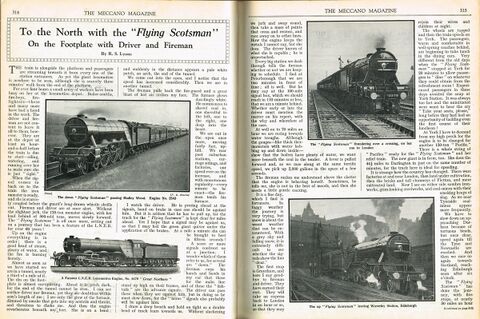
1928: Non-stop service and corridor tenders
The LNER publicity department got a "second bite of the cherry" in 1928 with regards to the Scotsman by relaunching the train service on 1st May as a new non-stop service, without the stop-off for lunch along the route that was originally part of the schedule. With a distance of 392 miles, this gave the Scotsman train the ability to boast of being the World's longest non-stop scheduled steam locomotive-run service.
Since it was impractical to expect a single driver and fireman to stay alert and shovel coal for the entire trip without a break, the new service was only made possible by the construction of a new type of tender to be attached to the engine, which, as well as carrying an extra ton of coal, contained a concealed tunnel that let first- and second-shift crews swap places without stopping the train. The engine-facing end of the tender had a small hatch over this tunnel-corridor, which ran inside the right-hand side of the tender, then had a sharp turn leading to a central concertina-style connector that linked to the front of the third-class carriage at the front of the train, where crews would sit when off-shift. Daylight entered the corridor from a small round window at the back of the tender, so as not to spoil the symmetrical appearance of the tender sides.
These innovative corridor tenders were also used with some other LNER express passenger locomotives such as the A4s, and were instrumental in making the Scotsman's Australian tour feasible.
1929: Feature film: "The Flying Scotsman"
The LNER cooperated with filmmakers in the production of a six-reel silent film called "The Flying Scotsman". Featuring the real locomotive on a loop of track, the film starred Pauline Johnson and included the first film appearance of Raymond Milland, and was later given a partial soundtrack. Although the film must have originally seemed to the LNER like a wonderful opportunity, they later became alarmed and then somewhat panicked at the idea that the plot involved a disgruntled sacked railway driver plotting to cause a railway accident, and featured some slightly terrifying stunts performed for real, without the use of stunt-men, such as actors crawling along the outside of the train at high speed.
1934: The 100mph speed record
In another publicity coup, the LNER organised a successful attempt to set a new official speed record for a steam locomotive, of 100mph.
The natural candidate for this was again 4472, not because it was necessarily any faster than its siblings, but because the name "Flying Scotsman" would then also be famous for belonging to the world's fastest steam loco.
The record-breaking run was made on 30 November 1934, with the driver cryptically mentioning to one of the passengers before the train left that station that, "If we hit anything today, we'll hit it hard". A special measurement "dynamometer car" was attached to the train to make sure that there was an official record of the event – a steam loco had been reputed to have travelled briefly at 100mph before, but without independent verification - the LNER wanted their record-breaking run to be "proper", official and undisputable.
1959: A3 rebuild
A set of modifications and improvements to the A1 class had started being implemented (very slowly!) in 1928, with the resulting locomotives being reclassified as A3 Class.
The "A3" updates to Scotsman were finished in 1959, giving it an improved boiler and an enhanced "Kylchap" double-chimney similar to the one on Mallard, and an elongated steam dome. However, the internal efficiency improvements, which meant that more energy was extracted from the steam, meant that smoke and steam didn't blast out of the chimney as strongly, and tended to drift across the driver's field of view.
In order to fix the problem, the same solution used by many other locomotives such as the "Duchesses" was applied - fixing a pair of smoke-deflector panels to the sides of the front of the loco, to scoop up air to lift the smoke out of the way. However, while many locomotives looked great with smoke deflectors, the high "partial" plates used on Scotsman while preserving the view of the loco's distinctive lower front boiler supports, were felt by many to make the loco look a bit "prissy", changing its look.
1963: Private ownership
Although steam locomotives were not too expensive to build, they were very expensive to maintain, and with the number of steam locomotives on the BR network steadily reducing, there was bound to come a time when maintaining the steam locomotive servicing facilities for a dwindling number of engines would cease to make financial sense. British Rail made a strategic decision to scrap steam, with the Scotsman locomotive scheduled to be sent to the breaker's yard in early 1963.
At this point, businessman Alan Pegler, who had stood in the cab of the Scotsman as a child when it was exhibited at the British Exhibition, stepped in and bought the locomotive from British Rail, with an agreement that he would be allowed to continue to run it on the BR network for special trips. With Scotsman no longer a BR locomotive, Pegler had the engine restored to its original LNER/4472 livery, and ran an anniversary-non-stop trip in 1968 to mark the 40th anniversary of the 1928 record-making run.
1969-1970: The first US Tour
The North American tour of The Flying Scotsman would take it 3,500 miles from its home in Britain before starting its 15,400 mile-long journey, taking it across much of America and even as far as Canada. The tour was originally a mission of goodwill to promote trade and cooperation between British and American businesses with attention drawn to British exports to the States. It also allowed the organisers to display the pride felt with the ongoing restoration of such a famous locomotive. The American Southern Railways System and its president played official hosts to the Scotsman while it travelled across their railways and assisted in organising parts of the tour that took the locomotive to the networks of other US railway companies. With the American recipients of the Scotsman and the British government participating in and backing the venture, the tour gained much excitement and momentum from both countries.
As well as its ongoing restoration, the locomotive itself underwent several modifications, to ensure its compliance with the Federal Railroads Administrations regulations on locomotives. Many of these were in regard to the difference between the safety rules of Britain and America. The most noticeable of these modifications were the addition of a "cowcatcher", an additional bell, and an American-style whistle. Additional safety modifications included an airbrake system and a high intensity headlamp.
The Flying Scotsman departed from Liverpool docks on 19th September 1969 for a ten-day voyage to Boston. Upon its arrival the Scotsman was greeted with the sound of traditional Scottish bagpipes and was unloaded by US Navy cranes and equipment. The Scotsman's first voyage in America would be from Boston, Massachusetts to Hartford, Connecticut. The rest of the 1969-70 season would take the locomotive to New York, Washington and Dallas. This three-month tour proved to be a popular season as the public were described as "waiting in scores" to watch the locomotive pass by, at one point including a whole class of school children who were dismissed early to allow them to view the Scotsman passing by.
The following year the Scotsman would visit Texas, Wisconsin and Montreal.
1972: The second US Tour
Pegler had loved driving the locomotive and running the first tour, and in 1972, with the loco still in the US, he decided to run another on the West Coast, this time without the sponsorship that had helped to support the enterprise the first time around. With finances becoming ever worse, Pegler carried on with the adventure, until he had to declare himself bankrupt towards the end of 1972.
Scotsman" was warehoused in the US and held as an asset, so that it could be sold to raise money to pay creditors.
1973: Rescue and return to the UK
Anxious that Britain might never see the Flying Scotsman again, William McAlpine stepped in and cleared the debts, and brought Scotsman back to Liverpool docks via the Panama Canal in early 1973. MacAlpine ran Scotsman for over two decades, including multiple refits and repairs.
1988-1989: Australia
The Scotsman went to Australia in 1988 to participate in the bicentennial anniversary steam railway event Aus Steam '88.
In 1989, the Scotsman set a steam endurance record, travelling 422 miles non-stop.
1996-2003: Flying Scotsman Enterprises
With a further major overhaul looming, McAlpine put the locomotive up for sale, and it was bought for £1.45M by Tony Marchington. to be further restored. With the refit taking over four years and costing around three quarters on a million pounds, Flying Scotsman Enterprises ran the loco for around another four years before becoming insolvent. Scotsman was on the block once again.
2004-: The National Railway Museum
The National Railway Museum managed to raise the money to buy Scotsman in April 2004, bringing the locomotive back into public ownership, and giving Scotsman a secure place in what many would consider it's natural home, at an organisation dedicated to preserving British railway history, and with the resources to maintain the engine and show it to the British public. Critically, the NRM only came into existence in 1975 to manage a collection that had previously been looked after by BR, and therefore hadn't existed at the time that Scotsman was originally scrapped.
Scotsman's lengthy overhaul and refit at the NRM finally resulted in the first of a series of public tours around the national railway network in early 2016.
Running numbers and liveries
The loco first appeared with the LNER's 4472 running number. After reorganisations, it also ended up numbered 502, and then 103, and when British Rail inherited it, this gained a "60" prefix to become 60103.
The Scotsman was originally dressed in LNER apple-green, which is how it's usually depicted. However, during World War Two the locomotive was painted in standard wartime black, and for a period under British Rail, it was BR "Brunswick Green".
Together with the conversion from A1-Class to A3-Class, and the fitting of the upper smoke deflectors, the array of colours, numbers and configurations has created no end of arguments amongst steam enthusiasts as to the "proper" state that Scotsman ought to be restored to. Should it have the original single chimney, apple-green paint and 4472 number? Or should it be Brunswick green, with smoke deflectors and numbered 60103? Or some other combination? The NRM's current position is that the Scotsman has been restored and updated so many times, the most appropriate state to return it to is the configuration that it had at the end of its period with British Rail.
Museum models
As well as conventional commercial locomotive models and toys of the Flying Scotsman, the Museum also used to have a large 2.5-gauge model on display in a glass case upstairs in Brighton Station, set into the glass wall of the ticket office to commemorate the locomotive's visit to Brighton in 1966. This was removed when the station was renovated and partially redesigned in 2012-2013.
See also:
External links
history:
- About the Flying Scotsman, National Railway Museum (nrm.org.uk)
- The engine: Why is Flying Scotsman famous? (ingenious.org.uk)
- List of LNER Class A1/A3 locomotives (wikipedia.org)
films:
- "The Flying Scotsman" (1929), Internet Movie Database (imdb.com)
- 4472 Flying Scotsman. The worlds most famous Steam Locomotive. (youtube.com) – video
Australia:
restoration:
- Full steam ahead as Flying Scotsman set to return to mainline by end of 2015 (theguardian.com)
- Restoration photos - August 2015 (nrm.org.uk)
- Damning Flying Scotsman report issued by National Railway Museum, April 2013 (rail.co.uk)
2016:
Subcategories
This category has only the following subcategory.
F
Pages in category ‘Flying Scotsman (locomotive)’
The following 11 pages are in this category, out of 11 total.
F
- Flying Scotsman (Train Running Day)
- Flying Scotsman 4472 locomotive, steam-powered (Märklin)
- Flying Scotsman locomotive 4472 (2.5" gauge)
- Flying Scotsman locomotive biscuit tin LNER 4472 (Crawfords Biscuits)
- Flying Scotsman locomotive, gauge 0, BR 60103 (Corgi Bassett-Lowke)
- Flying Scotsman locomotive, gauge 0, LNER 4472 (Bassett-Lowke)
- Flying Scotsman No3 locomotive 4472 (Hornby Series)
- Flying Scotsman presentation set 4-344 (Trix Twin Railways)
Media in category ‘Flying Scotsman (locomotive)’
The following 36 files are in this category, out of 36 total.
- Bassett-Lowke advert Royal Scot Flying Scotsman.jpg 2,492 × 1,602; 334 KB
- Bassett-Lowke trains and boats (MM 1934-06).jpg 775 × 1,024; 162 KB
- Bassett-Lowke, Flying Scotsman, gauge 0 (BL-MR 1937-11).jpg 1,545 × 2,152; 562 KB
- Bassett-Lowke, Flying Scotsman, gauge 0 components (BL-MR 1937-11).jpg 2,544 × 1,644; 522 KB
- Bassett-Lowke, Flying Scotsman, gauge 0 components list (BL-MR 1937-11).jpg 1,597 × 2,485; 739 KB
- Bowman Loco 234.jpg 1,086 × 672; 103 KB
- BR 60103 Flying Scotsman (BLCat0-00 1954).jpg 1,155 × 1,600; 419 KB
- Flying Scotsman 4472 at signalbox, 00-gauge layout.jpg 3,200 × 2,134; 3.61 MB
- Flying Scotsman 4472 at signalbox, low angle.jpg 3,200 × 2,134; 3.54 MB
- Flying Scotsman BR 60103 (BLCat 1952-autumn).jpg 3,000 × 1,987; 1.26 MB
- Flying Scotsman corridor tender, cab view (TRM 1928-05).jpg 999 × 1,200; 329 KB
- Flying Scotsman corridor tender, rear view (TRM 1928-05).jpg 1,171 × 2,000; 896 KB
- Flying Scotsman corridor tender, through view (TRM 1928-05).jpg 908 × 1,800; 588 KB
- Flying Scotsman LNER 4472 (WBoR 14ed).jpg 2,500 × 1,959; 1.16 MB
- Flying Scotsman LNER 4472 biscuit tin, Crawfords, detail.jpg 2,500 × 1,409; 1.73 MB
- Flying Scotsman LNER 4472 biscuit tin, Crawfords, tender detail.jpg 2,500 × 1,667; 2.14 MB
- Flying Scotsman LNER 4472 with new tender (TRM 1928-05).jpg 4,337 × 1,265; 1.13 MB
- Flying Scotsman locomotive, card model (Trix1800 SC3).jpg 1,585 × 764; 560 KB
- Flying Scotsman locomotive, cross-section (WBoR 14ed).jpg 3,000 × 1,855; 2.33 MB
- Flying Scotsman nameplate artwork.jpg 1,200 × 459; 68 KB
- Flying Scotsman non-stop service (TRM 1928-05).jpg 777 × 1,200; 295 KB
- Flying Scotsman Train Running Day (2015).png 1,920 × 1,081; 219 KB
- Flying Scotsman Train Running Day, BTMM October 2015.jpg 2,500 × 1,407; 1.82 MB
- Flying Scotsman with bus.jpg 1,600 × 900; 965 KB
- Flying Scotsman, article (MM 1928-04).jpg 1,200 × 798; 600 KB
- Hornby E320 Locomotive, LNER 4472 Flying Scotsman (HBoT 1934).jpg 2,001 × 1,293; 396 KB
- Hornby M0 Locomotive 4472 (HBoT 1930).jpg 2,824 × 1,481; 539 KB
- Hornby Trains, Flying Scotsman 4472 box artwork, rectangular sticker (Meccano Ltd).jpg 2,400 × 1,798; 3.02 MB
- Hornby Trains, Flying Scotsman 4472 box artwork, round sticker (Meccano Ltd).jpg 2,400 × 1,796; 3.5 MB
- Locomotive LNER 4472 Flying Scotsman, gauge 0 (Bassett-Lowke).jpg 1,024 × 768; 414 KB
- Model Locomotive Building, Bassett-Lowke.jpg 1,600 × 534; 251 KB
- The Flying Scotsman, Bob Gwynne, 0747807701 (Shire Library).jpg 848 × 1,200; 168 KB
- The Wonder Book of Railways, 14th edition, cover.jpg 921 × 1,200; 322 KB
- Three New Hornby Trains, Hornby No.3 locomotives (MM 1927-12).jpg 929 × 1,200; 527 KB
- Tri-ang Hornby Book of Trains, cover.jpg 1,543 × 2,200; 697 KB

